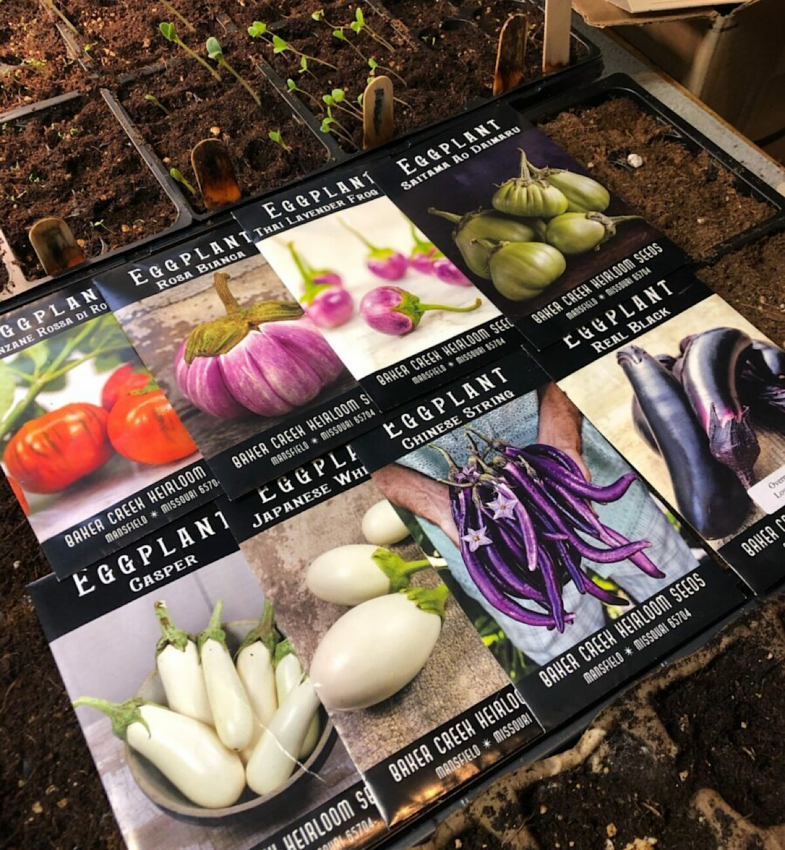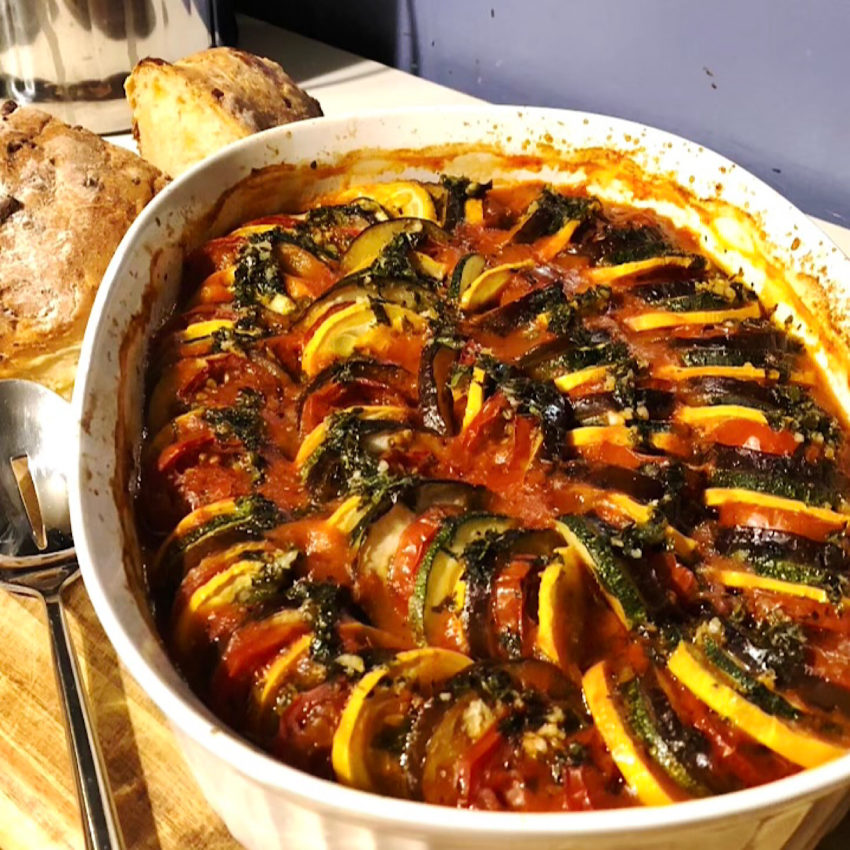With its broad leaves and lavender flowers, eggplants are a beautiful plant that produce a unique fruit used in many dishes from Italy, the Middle East, and India. This guide will help you grow heirloom or hybrid varieties of eggplants from seed and then guide you to transplanting out to a container or the garden

Jump to: Unique Varieties | Starting from Seed | How to Grow | Cooking with Eggplant
This post may contain affiliate links. As an Amazon Associate, I also earn from qualifying purchases. You can read our disclosure information here–
Growing Unique Heirloom Varieties of Eggplant
Finding any variety of eggplant other than the “Black Beauty” types at a plant nursery is very uncommon. If you want to grow some of the more unique heirloom varieties you will most likely need to start them from seeds.
For eggplant seeds, I found Baker Creek Heirloom Seed Company to be a dependable seed supplier with a great selection and reputation.
Some of the great heirloom varieties to try would include:
White Varieties (Solanum melogena)
- Casper – A Ivory-white fruit with a very mild mushroom-like flavor. Medium in size. A prolific variety.
- Japanese White Egg – White fruit that is rich in flavor and perfect for stir-frying. A heavy yielding plant with 2″-3″ fruit.

Lavender Varieties
- Thai Lavender Frog Egg – This eggplants comes from Thailand and is the size of cherry tomatoes. This high yielding eggplant is lavender and cream in color. With its robust flavor it can stand up to a good curry, cooked whole.
- Rosa Bianca – This Sicilian variety is light pink with white shading and is gently scalloped. No bitterness in this fruit just a rich mild flavor used by many chefs.
Other Unique Varieties
- Melanzane Rossa Di Rotonda (Solanum aethiopicum) – Traditionally grown in Italy, this is the only red variety. Tomato shaped and smooth, it is sure to be a favorite to grow.
- Saitama Ao Daimaru (Solanum melongena) – A dense creamy textured fruit from Japan. The apple green eggplant is a gourmet choice.

Starting Eggplants from Seed
Starting eggplant from seed is best done indoors six to eight weeks before the last frost.
The seeds should be sowed 1/4 inch deep in a sterile soilless mix (i.e., potting soil). Potting soils do not contain actual dirt from the garden, but rather it is a mix of organic matter like peat, wood chips, or coco coir, perlite and/or vermiculite, and often a slow-release fertilizer.
In order for eggplant seeds to germinate the soil needs to be quite warm. Bottom heat is usually the easiest way to keep the soil consistently warm until they germinate.
Propagation mats are a popular method of providing warmth for germination. These can be found for purchase at most plant nurseries.
Once they germinate and you begin to see the seedling emerge from the soil the bottom heat can be removed. At this point you want to place the seedlings under a grow light or a light source to avoid getting leggy with weak stems.
The ambient temperature should be kept around 65 to 70 degrees Fahrenheit.
What to do before planting seedlings outdoors
Once a seedling has a set of two “true leaves” it can then be transplanted into a 3-4 inch pot if the outdoor soil is still to cold to plant out.
If the warm weather has become stable and the soil is warm you can start to harden off the seedlings without transplanting to larger pots.
Hardening off seedlings means gradually exposing them to the outdoors by placing them outside a few hours a day on mild days in late spring. This allows the plant to become accustomed to wind and natural sunlight.
Tip: sow a few more seeds than you think you will need for planting to ensure enough seeds germinate and make their way to becoming full plants.

How to Grow Eggplants in Pots
Eggplants grow really well in pots or containers. In addition to the wonderful vegetables they produce, they are very attractive plants and look beautiful on patios, balconies or bordering driveways. They have large leaves and beautiful lavender flowers before fruiting, and add a deep color after fruiting.
To get a lot of healthy eggplants, plant in a large pot. They will thrive if they have a pot of their own, but you could plant two eggplants in a large pot if you are compromised for space.

When planting in containers, use potting soil rather than garden soil. You also will need to water and fertilize more frequently when growing plants in containers.
Stick you finger in the soil and if the soil is dry down to 1 inch, it is time to water. Depending on your container and the weather, you may need to water daily.
With respect to fertilizing container plants, the best way to tell when they need fertilizer is to observe the leaves. If they are starting to yellow, they may need some more nitrogen. Ask your local nursery for a well balanced fertilizer (balanced N-P-K).
Growing Eggplants in the Garden
The most important thing to consider when transplanting eggplant seedlings outdoors is the warmth of the soil. They are heat loving plants and the warmth of the soil is more important than the warmth of the air.
Here are some other tips for successful growing in the garden:
- Prepare Soil: a week before planting seedlings in the garden, work in any compost or amendments that you soil needs to be well-drained and nutritious. Eggplant prefers a rich loose soil that is well drained. An ideal pH would be 6.
- Temperature: Plant after the danger of a frost is over, when over night temperatures below 50 degrees F. Make sure the soil is warm down 2-3 inches. Eggplants love heat, if you are gardening in a northern climate you may want to lay down clear plastic to warm the soil (remove before planting). Some people will use black plastic to plant in as it can control weeds and keep the ground warm. I am not a fan of planting into black plastic as I find the weeds grow through it and it is a mess to pull up every year. Not to mention that plastic is not the most environmentally friendly thing around.
- Water: As long as the eggplant get an inch of water a week then they should be fine. Soaking the ground thoroughly will be necessary if there is less rain fall than that.
- Fertilization: You can add a foliar fertilizer or a soil fertilizer when needed. Get a balanced NPK fertilizer and read the directions regarding dilution (undiluted fertilizer can burn plants). Observe you plants. If your soil is really healthy and full of compost you may not need any fertilizer.
- Staking: Some varities of eggplant can become dense and heavy, this may pull the plant over. Placing a stake next to the plant and securely tying the plant to it should prevent this from happening. This isn’t always necessary, but something to watch for. Staking at first site of the plant bending will help prevent any long term damage to the stem. This also keep the fruit from resting in the soil where it may begin to rot.

Pest and Diseases
Eggplants don’t attract too many pests, but there are a couple to watch for.
Flea Beetles are small, shiny-coated beetles with large rear legs, which allow them to jump like fleas when threatened. They will make small holes in the leaves of the plant. They overwinter and reappear when the temperatures rise above 50 degrees, just when seedlings are being planted. Watch for these as they will damage the young plant.
Once the plant is established the small holes won’t cause much damage. However, the flea beetle can carry diseases from other plants that they are munching on. This makes it important to rid your garden of them.
Colorado Potato Beetle are oval in shape and 3/8 inch long. They are yellow-orange with yellowish white wings with 10 narrow black stripes. The eggs are laid in clusters of bright yellowish-orange oval eggs on the underside of leaves. As their name indicates, they typically attack potato plants, but they enjoy other nightshade plants as well.
They are at their worst in midsummer when the larva begin to hatch. The best way to combat this is to look for the larvae in spring and early summer and simply crush them.
The good news is that both beetles tend to leave the fruit alone, only being interested in the leaves.
Favorite Ways to Eat Eggplant:
Eggplant’s versatility makes it wonderful in so many dishes from appetizers, sides, to the main course. And since varieties of eggplant are grown around the world, they appear in many cuisines.
Eggplant also makes a great mushroom substitute because of its similar texture.

Appetizers:
Baba Ganoush – consisting of cooked mashed eggplant with olive oil, lemon juice, and seasonings. Spread on warm bread or pita for a unique experience.
Kosovar Ajvar recipe – this is a red pepper and eggplant spread. It can be used as a spread on a charcuterie board or as a sauce on meat and vegetable kababs.
Grilled Eggplant – lightly grilled eggplant topped with a slice of heirloom tomato, a dollop of goat cheese, and a sprig of basil. Simple and delish.
Side Dishes:
Roasted Eggplant – toss chunks of eggplant with seasoning and olive oil. Bake for 20-25 minutes at 400 degrees
Breaded Eggplant – dip slices of eggplant in egg then dredge in flour and spices, pan fry in oil. Serve with your favorite dipping sauce.
Main Dishes:
Eggplant Parmesan – breaded and fried eggplant layered in cheese and a rich tomato sauce, what is not to love.
Low-carb Ratatouille recipe – a perfect late summer garden dish. Wow your dinner guests with this easy to make yet stunning “tian” or ratatouille, using the best of the late summer garden: tomato, zucchini, bell pepper, basil, and eggplant.

If you like my articles about cooking and gardening, subscribe to my weekly newsletter, where I share free recipes and gardening tutorials.


Leave a comment